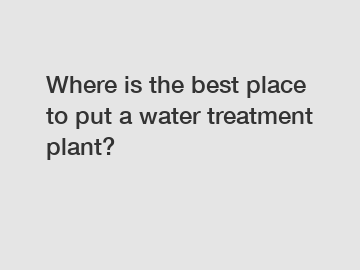Where is the best place to put a water treatment plant?
The best place to put a water treatment plant depends on a variety of factors, including the availability of water sources, the population size, and the geographical location. In this article, we will explore the factors that influence the optimal location for a water treatment plant and the significant impact it has on a community's access to clean water.
One of the primary considerations for locating a water treatment plant is the availability and quality of water sources. It is essential to choose a location near a reliable and sufficient water supply. Access to a nearby river, lake, or groundwater source is crucial for efficient water treatment operations. Proximity to the water source helps in minimizing transportation costs and energy consumption, as well as reducing the chances of contaminants entering the water during transportation.
Another important factor to consider is the population size and distribution. Water treatment plants should ideally be located near densely populated areas to ensure a sufficient supply of clean water to meet the community's needs. By strategically placing the plant closer to the targeted population, the distribution network is shortened, reducing the chances of water loss during transportation.

Geographical location is also a vital aspect when determining the best place for a water treatment plant. Coastal regions might face unique challenges, such as saline intrusion into freshwater sources, requiring specialized treatment processes. Similarly, areas prone to natural disasters like floods or earthquakes require resilient infrastructure to ensure the uninterrupted supply of clean water during emergencies.
Moreover, the environmental impact must be considered. Constructing a water treatment plant near sensitive ecosystems or wildlife habitats can cause adverse effects on the environment. Therefore, it is crucial to conduct thorough environmental assessments and implement appropriate mitigation measures to minimize any potential negative impact.
Choosing an optimal location for a water treatment plant has significant implications for the community it serves. Access to clean and safe drinking water is essential for public health and plays a crucial role in preventing waterborne diseases. By locating the plant near the target population, the distance traveled for water delivery is reduced, leading to increased efficiency and cost-effectiveness. Additionally, a strategically placed water treatment plant can have positive economic impacts by attracting businesses and industries to the area, enhancing overall development and growth.
In conclusion, the best place to put a water treatment plant depends on various factors, including the availability of water sources, population size and distribution, and geographical location. Considering these factors not only ensures efficient water treatment operations but also maximizes the impact of clean water accessibility for the community. By meticulously selecting the optimal location, we can pave the way for healthier and more sustainable communities.
If you want to learn more, please visit our website Environmental Flow Regulation And Control Weir, remote control hydraulic dam manufacturer, Advantages of Movable Simplified Elevated Dam.

Comments
0